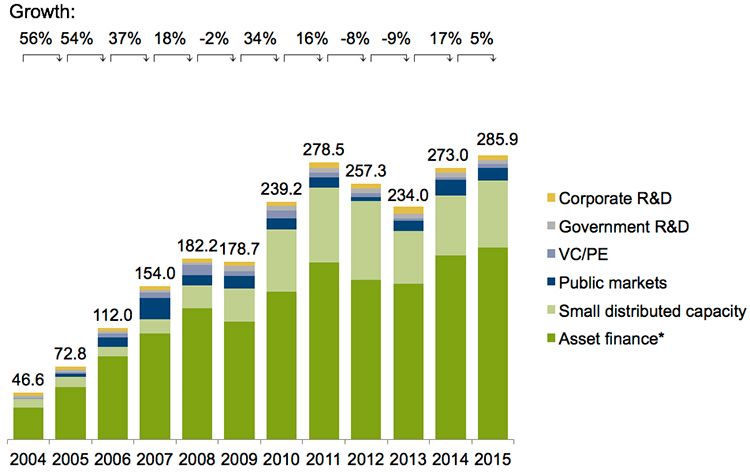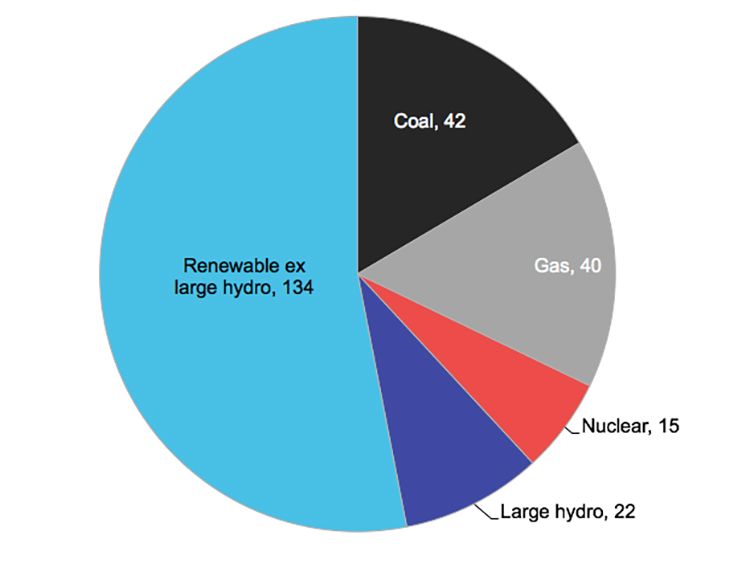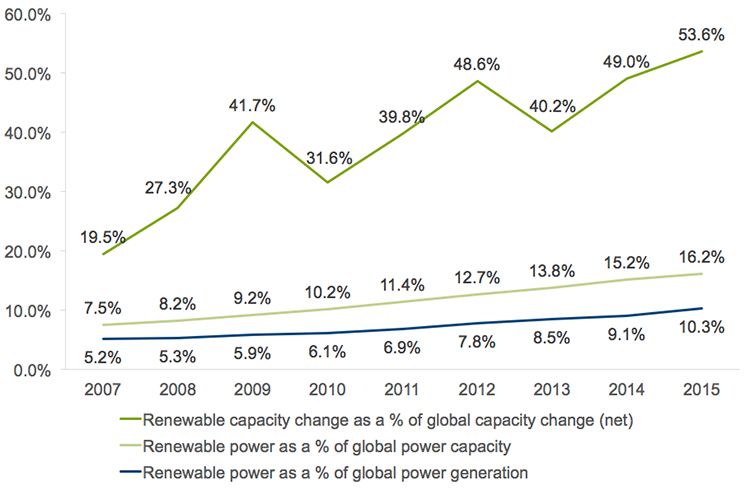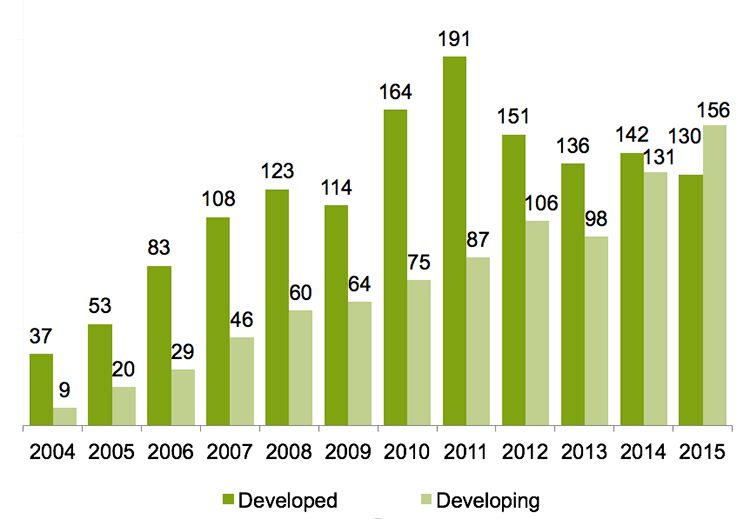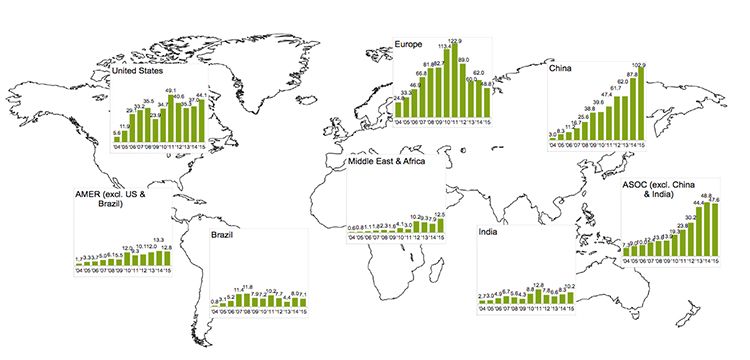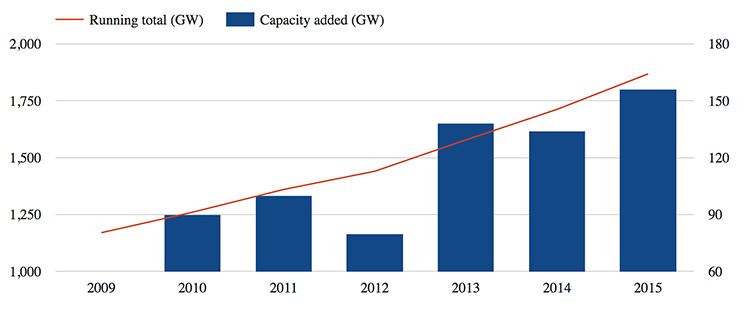
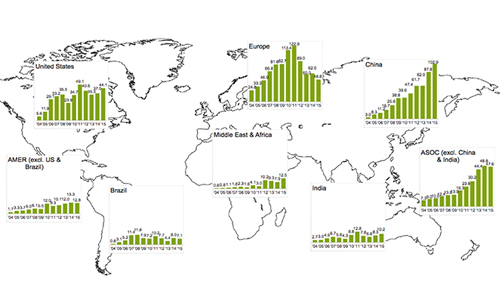
Global investment in renewable energy reached record levels in 2015, according to a new report from the UN Environment Programme (UNEP) and Bloomberg New Energy Finance (BNEF).
More surprisingly, perhaps, the report shows that the $286bn poured into green energy was more than double the spending on coal– and gas-fired power.
It also shows, for the first time, that more renewable power capacity was added than other sources and that renewable energy investment was mostly in developing countries.
Carbon Brief runs through the key findings in seven charts.
1. Record Renewables
Investment in renewable energy reached a record $285.9bn in 2015, UNEP and BNEF say. That was up 5 percent on a year earlier and surpassed the previous peak of $279bn in 2011.
2. Low-Carbon Takes Over
Investments in low-carbon sources of electricity, such as renewables, large hydro and nuclear, were much higher than for fossil fuel generation. The record $262bn renewable investment in 2015 was more than twice the $130bn that went into coal and gas.
In fact, this has been the case for several years, highlighting the extent to which low-carbon, generally and renewables, in particular, have become mainstream.
However, it’s worth noting that investments in oil and gas exploration and extraction easily eclipse spending on new electricity generation capacity. Despite huge spending cuts in the wake of the oil price crash, oil and gas investment in 2016 is expected to be $522bn, down from $595bn in 2015.
3. Majority Stake
Last year also saw renewables, excluding large hydro, account for more than half of new power generation capacity for the first time. Of the 253 gigawatts (GW) added around the world in 2015, 134GW was from renewables excluding large hydro.
The world’s fossil-fired capacity also increased. After accounting for closures, global coal capacity increased by 42GW and gas by 40GW. Nuclear capacity grew by 15GW.
4. Rising Share
Despite renewables dominating capacity growth in 2015, it’s worth remembering that the world continues to rely heavily on fossil fuels to generate its power. Renewables supplied 10 percent of global electricity, excluding large hydro.
Including large hydro, renewables’ share of global electricity generation rises to more than 20 percent.
5. Developing World Dominates
The UNEP report shows, for the first time, that most renewable energy investment was in developing nations. This trend appears to be accelerating as ambition soars in China and India, while stalling across Europe.
6. China’s Surge
This regional split is seen even more clearly on the map, below. China, which now spends more on renewables than the U.S. and Europe combined, has ambitious plans to double its wind capacity and treble its solar capacity during its next five-year plan to 2020.
In contrast, spending in Europe has more than halved since a 2011 peak and has now fallen back to 2006 levels. U.S. investment has been relatively steady. The recent extension of wind and solar tax credits should ensure this continues.
7. Falling Costs
As well as reaching record levels of investment, renewable capacity added in 2015 was the highest ever too. That’s partly thanks to renewables getting cheaper, with each dollar buying more capacity.
In 2015, spending was 3 percent higher than in 2011. The 156 gigawatts (GW) added, however, was 56 percent larger than the 100GW installed in 2011.
YOU MIGHT ALSO LIKE
Feds Find Offshore Fracking in the Pacific Would Have No ‘Significant’ Environmental Impact
New York State Assembly Passes Nation’s Most Ambitious Climate Bill
Scottish Parliament Passes Motion in Support of Outright Fracking Ban

 233k
233k  41k
41k  Subscribe
Subscribe 
